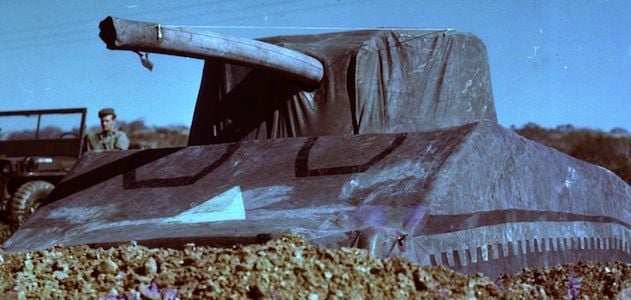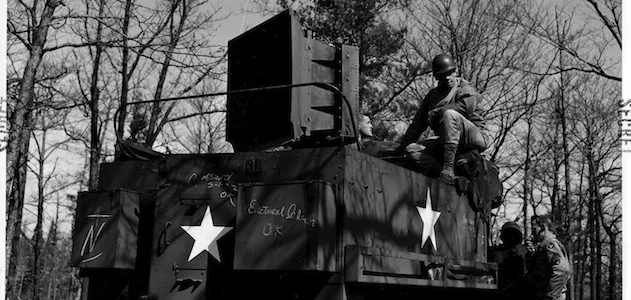When an Army of Artists Fooled Hitler
A new documentary shares the story of the 23rd unit’s daring deceptions
/https://tf-cmsv2-smithsonianmag-media.s3.amazonaws.com/filer/resources-GAPR6PaintingofSurprisedCyclists-631x300.jpg)
Shortly after the D-Day invasion on June 6, 1944, two Frenchmen on bicycles managed to cross the perimeter of the United States Army’s 23rd Headquarters Special Troops and what they saw astounded them. Four American soldiers had picked up a 40-ton Sherman tank and were turning it in place. Soldier Arthur Shilstone says, “They looked at me, and they were looking for answers, and I finally said: ‘The Americans are very strong.’”
Patriotic pride aside, the men of the 23rd were not equipped with super-human strength. They did, however, have inflatable tanks.
Shilstone was one of 1,100 soldiers who formed the unit, also known as the Ghost Army. They were artists and illustrators, radio people and sound guys. Handpicked for the job from New York and Philadelphia art schools in January 1944, their mission was to deceusuive the enemy with hand-made inflatable tanks, 500-pound speakers blasting the sounds of troops assembling and phony radio transmissions.
Over the course of the war, they staged more than 20 operations and are estimated to have saved between 15,000 and 30,000 U.S. lives. The illusion was never broken and not even their fellow soldiers knew of their existence.
Kept secret for 40 years, the story of the Ghost Army first broke in Smithsonian magazine in the April 1985 issue, when then-illustrator Shilstone shared his part in the war. Now, Shilstone and 18 other members of the 23rd are part of the new PBS documentary, “The Ghost Army.”
When he first began researching the story, director Rick Beyer says he was amazed. “First you think, maybe I’m misunderstanding or maybe it was just one time,” says the director. It’s a skepticism he’s since encountered on the road, including at a presentation for seniors at the Perkins School for the Blind in Massachusetts. “There was one guy, while I was setting up and he was just convinced that the whole thing was bullshit.” He told Beyer he had served in General Patton’s Third Army and never knew of any Ghost Army. But Beyer continued with his screening. Afterward the same man approached him and said, “This is the most amazing story I ever heard!”
“It’s a great example of how many fantastic, amazing, sort of mind-bending stories there still are 70 years later coming out of WWII,” says Beyer.
Deception has long been a part of war, the Trojan Horse being perhaps the most famous example. But what set the 23rd troops apart, says Beyer, is the way they integrated so many different strategies to create a multimedia roadshow capable of being packed up for another show the next night. To shore up potential holes in the line, the unit would set up its inflatable tanks and roll in the giant speakers with a 15-mile range to give the impression that a huge army was amassing. Coupled with decoy radio transmissions, the deceptions proved largely successful.
From the beaches of Normandy to the Battle of the Bulge, the Ghost Army saw a lot of action, but their biggest stunt would come near the end of the war. With the American Ninth Army set to cross the Rhine river deeper into Germany, the 23rd had to lure the Germans away. Posing as the 30th and 79th divisions, 1,100 men had to pretend to be more than 30,000.
Mixing real tanks alongside the inflatable ones, the troops appeared to be assembling a massive attack. Their fake observation planes were so convincing, American pilots tried to land in the field next to them. When the offensive finally made its move across the Rhine, with General Dwight Eisenhower and Prime Minister Winston Churchill watching, they were met with little German resistance. The riverbanks were left for the taking and the Ghost Army earned a commendation for its success.
Because the men had to keep their true purpose a secret, they regularly pretended to be other units. They’d mark their trucks with chalk or sew fake badges to throw off potential spies in the cities where they spent time off duty.
Set apart from other troops by their secret mission, the artists also brought an unusual perspective to war. Upon finding a bombed-out church in Trévières, several of them stopped to sketch the structure. When they stopped in Paris and Luxembourg, the men recorded everything from the beguiling women biking by to the scenic rooflines and street scenes. Beyer accumulated more than 500 of these sketches during the eight years he spent on the documentary, many of which were included in an accompanying art exhibit at the Edward Hopper House in New York.
“In war stories,” explains Beyer, “it tends to be about the guys on the line under fire or the generals planning strategy in the headquarters. What you don’t get always is the sense of what the experience is like for the people.”
“Whether it’s visiting a bordello or sketching a bombed out church or trying to comfort the orphaned Polish children in a [Displaced Persons] camp on a dreary Christmas in Verdun when you’ve just retreated from the Battle of the Bulge, those sorts of stories are part of the G.I. experience also and I wanted to convey this humanity as part of the story,” says Beyer.
The Ghost Army returned to the United States in July 1945, thinking they would join in the invasion of Japan. But after the Hiroshima and Nagasaki bombings and Japan’s surrender, the unit was deactivated on September 15, 1945.
Many of the members of the special unit went on to have careers in the arts, including painter and sculptor Ellsworth Kelly and fashion designer Bill Blass. Unable to tell their wives, family and friends about what they had done until the information was declassified, their stories didn’t make it into the official narratives of WWII. Beyer says there’s more still to discover, “There are things that are still hidden away about it.”
In the meantime, Beyer hopes his documentary can help counter the traditional assumption that British deception, most known for Operation Fortitude, which sought to divert German attention away from Normandy, was elegant while American efforts must have been clunky. “It shows how creative and imaginative American deception units were,” says Beyer.
Retired commander of NATO General Wesley Clark agrees in the documentary, saying, “The essence of winning is the defeat of the enemy’s plan.” And with imagination and creativity, that’s precisely what the Ghost Army was able to do.
“The Ghost Army” premiers on Tuesday, May 21 on PBS.
/https://tf-cmsv2-smithsonianmag-media.s3.amazonaws.com/accounts/headshot/Leah-Binkovitz-240.jpg)






/https://tf-cmsv2-smithsonianmag-media.s3.amazonaws.com/accounts/headshot/Leah-Binkovitz-240.jpg)